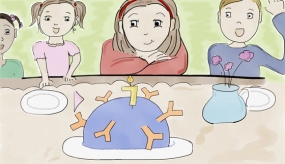
Soon there will be a new superhero children’s book available, but these superheroes aren’t from Marvel comics. The book, Rose’s Superhero Birthday: An Immune Cell Treasure Hunt, is about the immune cell superheroes that keep us healthy.
Angela Landrigan, PhD, did her graduate and postdoctoral training in immunology at Stanford’s medical school, where she studied how immune cells respond to cancer. She now works at a private company that develops software used to analyze immunology “big data.” She’s also a busy mom to two energetic, curious girls, which led her to write and illustrate a new children’s book to make learning about the immune system fun. I spoke with Angela last week about her new book, which she plans to distribute on her website.
What inspired you to write a children’s book?
My kids led me to write this book, particularly my 4-year-old Violet. Sometimes I work from home analyzing datasets, and she’ll look over my shoulder and ask me all these deep questions about cells and what they do. Plus we talk through the details of everyday things, like if she gets a cut or flu shot. I realized that kids can pick up a startling amount of detail, and they’re so thirsty and eager for knowledge.
So I wrote the book to answer Violet’s questions, then I quickly realized that I have the opportunity to teach more children and even parents and caregivers about how our immune cells work. Immunology is becoming an increasingly popular topic in the public health conversation — anything from vaccine awareness to disease epidemics. My book can help people to have less fear of the unknown and to be better equipped to make decisions that influence their own lives and public health.
How did you develop the characters and storyline for your book?
The main character emerged because my daughter Violet wanted me to tell her new stories every night before bed. So I created this character Rose who goes on adventures.
The book follows a 7-year-old girl named Rose, who is really excited about science. She asks her immunologist-Mom for a science-themed birthday party with a B-cell birthday cake and a treasure hunt for stuffed animal immune cells. The next day, Rose invites all her friends over for a play date to create and act out a play on how immune cells work together in concert to get rid of a virus.
I’ve tried to capture the joy of creation, exploration and discovery of childhood, while engaging kids to thinker deeper.
Who is your target audience?
My target audience is families with children – mostly children between 4-10 years old, but along the way adults will learn too. And it’s often parents who make the decisions that influence public health.
I’ve tried to include characters with diverse demographics — boys and girls of multiple races. Hopefully readers can identify with the characters no matter who they are.

Why do you think your book is important and what do your daughters think of it?
This book helps bridge the communication gap between all that we’ve learned as researchers and what’s being communicated to the public. Having been a research immunologist, I feel like there is a deficit in what’s getting communicated.
The book also inspires kids to ask questions and dig deeper. Perhaps these kids will go on to discover the next generation of cures or become creative problem solvers in other ways. I want to capitalize on this time when kids are sponges, excited and eager to learn, by planting the seeds of curiosity about science and the world.
I particularly want to empower girls in science. I hope to inspire girls to identify with Rose, so science doesn’t feel like a topic they have to shy away from – and show them that you can be a mom and still do science. The power of role models is tremendous.
It’s been a fun, inclusive family project — not an extra demand that required carving out time away from my kids. My daughters have been really excited along the way to read the drafts over and over.
Are there any more books in your future?
Yes, I’m thinking of writing another Rose book — a “take-your-daughter-to-work” book where Rose goes to the lab with her Mom to learn about how scientists are manipulating the immune system for therapeutic benefit or investigational purposes. I’m also planning to write and illustrate a baby board book on immune cells called “Bedtime for B-Cell.” Another book in the concept phase is an encyclopedia with less narrative, covering topics like allergies, vaccines and asthma. These other books will build upon the concepts of my first book, delving deeper into the details.
Illustrations from Rose’s Superhero Birthday: An Immune Cell Treasure Hunt by Angela Landrigan
This is a repost of my Scope blog story, courtesy of Stanford School of Medicine.




